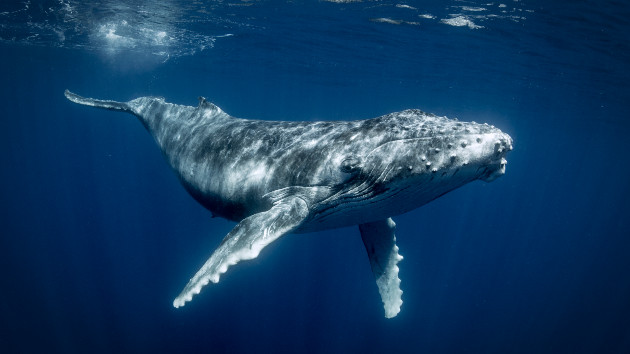(NEW YORK) — A discovery on how baleen whales are able to sing under water is giving scientists a better understanding on how noise pollution from shipping activity can alter marine mammal’s ability to communicate — and therefore thrive as a species.
When the ancient ancestors of whales returned to the ocean from land, they developed major adaptations to make vocal communication feasible under water, according to a study published in Nature on Wednesday.
A study into how whales produce their vocals beneath the ocean’s surface found that baleen whales — including the sei, common minke and humpback species — use specialized larynxes to communicate with each other under water.
The larynxes of three baleen whales that were examined were found to have adaptations that allow the animals to create massive air flows back and forth when they breathe in, Coen Elemans, a professor of sound communication and barrier at the University of Southern Denmark and author of the paper, told ABC News. While toothed whales evolved a nasal vocal organ, baleen whales were found to have a specialized structures to allow the production of sound and recycling of air while preventing inhalation of water, the paper found.
Because the frequency in which the whales sing would likely be low — with a maximum frequency of 300 hertz — the communication between baleen whales are likely severely impacted by human activity, as shipping vessels typically create noise between 30 hertz and 300 hertz, according to the paper.
When the noise from the shipping activity is present, it reduces the range in which the whales can communicate, which could then produce stress on the animals, Joy Reidenberg, a professor of anatomy at the Icahn School of Medicine at Mount Sinai in New York City, told ABC News.
“We think that this mechanism is an ancestral mechanism that these animals have used to make very low frequency sounds in an environment where sound is the only way of communication and the only way…to find animals that are very far apart,” Elemans said.
Unlike humans, who mainly rely on sight, whales live in a “completely acoustic world,” Sharon Livermore, director of marine conservation at the International Fund for Animal Welfare, told ABC News.
Vessel noise pollution and shipping intensity poses a real threat to large whales, Bekah Lane, a cetacean field research specialist at The Marine Mammal Center, a California-based nonprofit marine animal rescue center, told ABC News.
Research has shown that constant shipping noise can dominate the ocean soundscape and cause stress levels to rise in some species — especially the critically endangered North Atlantic right whale, Livermore said.
“under water noise is a pollutant, and it’s an invisible pollutant to the human eye,” she said.
Singing is only one of the sounds that whales make, said Reidenberg, who peer-reviewed the study. It is typically the males that sing, and the performances take place in tropical waters, where they look for mates.
Other forms of communications that whales made are calls — which are different from “singing” — and are especially used by mothers and other whales attempting to communicate with other individual whales, Reidenberg said.
“Their ability to hear and be heard is key to their survival,” Livermore said.
The deaths of five North Atlantic right whales since December has renewed calls for federal shipping regulations. Last week, a coalition of environmental groups filed a federal lawsuit to finalize shipping speed rules proposed in 2022 that would require mariners off the East Coast to slow down in order to reduce the risk of injury or death to the endangered whales.
However, consumer demand to have goods flow across oceans via large ships as quickly as possible adds another layer of complexity to the issue, Lane said.
“We need to think critically about how our consumer choices and purchasing power can have real consequences for marine wildlife,” Lane said.
The day after the lawsuit was filed, another North Atlantic right whale — a juvenile female — was found dead off the coast of Georgia, according to the National Oceanic and Atmospheric Administration.
Ongoing research efforts coupled with working directly with local harbor safety committees, the maritime industry and government agencies are necessary to find solutions to better protect whales, Lane said.
The researchers hope that technology in the future will allow them to study live whales — a feat nearly impossible at the moment considering how large the animals are. Technology such as a remote operated vehicle that could get close to a whale while it is singing and get ultrasounds would be ideal, Reidenberg said.
“I mean, we can’t put a whale in a CAT scan or an MRI,” she said.
Copyright © 2024, ABC Audio. All rights reserved.












